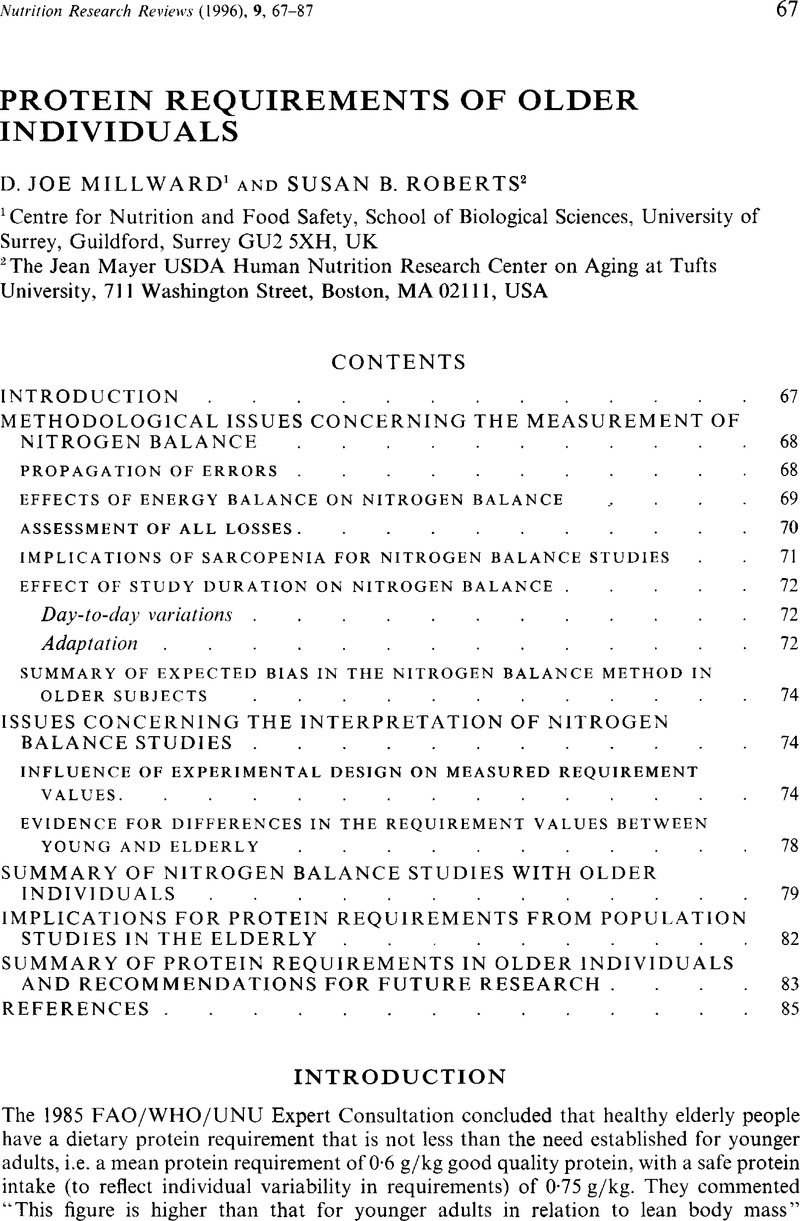Crossref Citations
This article has been cited by the following publications. This list is generated based on data provided by Crossref.
Millward, DJ
Fereday, A
Gibson, N
and
Pacy, PJ
1997.
Aging, protein requirements, and protein turnover.
The American Journal of Clinical Nutrition,
Vol. 66,
Issue. 4,
p.
774.
Fereday, A.
Gibson, N. R.
Cox, M.
Pacy, P. J.
and
Millward, D. J.
1997.
Protein requirements and ageing: metabolic demand and efficiency of utilization.
British Journal of Nutrition,
Vol. 77,
Issue. 5,
p.
685.
Beaufrere, Bernard
and
Boirie, Yves
1998.
Aging and protein metabolism.
Current Opinion in Clinical Nutrition and Metabolic Care,
Vol. 1,
Issue. 1,
p.
85.
Millward, D. Joe
1998.
Metabolic Demands for Amino Acids and the Human Dietary Requirement: Revisited.
The Journal of Nutrition,
Vol. 128,
Issue. 12,
p.
S2563.
Fukagawa, Naomi K
Yu, Yong-Ming
and
Young, Vernon R
1998.
Methionine and cysteine kinetics at different intakes of methionine and cystine in elderly men and women.
The American Journal of Clinical Nutrition,
Vol. 68,
Issue. 2,
p.
380.
Rand, William M.
and
Young, Vernon R.
1999.
Statistical Analysis of Nitrogen Balance Data with Reference to the Lysine Requirement in Adults.
The Journal of Nutrition,
Vol. 129,
Issue. 10,
p.
1920.
Arnal, Marie-Agnès
Mosoni, Laurent
Boirie, Yves
Houlier, Marie-Louise
Morin, Liliane
Verdier, Elisabeth
Ritz, Patrick
Antoine, Jean-Michel
Prugnaud, Jacques
Beaufrère, Bernard
and
Mirand, Philippe Patureau
1999.
Protein pulse feeding improves protein retention in elderly women.
The American Journal of Clinical Nutrition,
Vol. 69,
Issue. 6,
p.
1202.
Millward, D. Joe
1999.
The nutritional value of plant-based diets in relation to human amino acid and protein requirements.
Proceedings of the Nutrition Society,
Vol. 58,
Issue. 2,
p.
249.
Millward, D. Joe
1999.
Optimal intakes of protein in the human diet.
Proceedings of the Nutrition Society,
Vol. 58,
Issue. 2,
p.
403.
Young, Vernon R.
2000.
Nutrition and Immunology.
p.
49.
Young, Vernon R.
and
Borgonha, Sudhir
2000.
Nitrogen and Amino Acid Requirements: The Massachusetts Institute of Technology Amino Acid Requirement Pattern.
The Journal of Nutrition,
Vol. 130,
Issue. 7,
p.
1841S.
Cynober, Luc
Alix, Emmanuel
Arnaud-Battandier, Franck
Bonnefoy, Marc
Brocker, Patrice
Cals, Marie-Josephe
Cherbut, Christine
Coplo, Claire
Ferry, Monique
Ghisolfi-Marque, Anne
Kravtchenko, Thierry
Lesourd, Bruno
Mignot, Catherine
and
Patureau Mirand, Philippe
2000.
Apports nutritionnels conseillés chez la personne âgée.
Nutrition Clinique et Métabolisme,
Vol. 14,
Issue. ,
p.
3.
Morse, M. H.
Haub, M. D.
Evans, W. J.
and
Campbell, W. W.
2001.
Protein Requirement of Elderly Women: Nitrogen Balance Responses to Three Levels of Protein Intake.
The Journals of Gerontology Series A: Biological Sciences and Medical Sciences,
Vol. 56,
Issue. 11,
p.
M724.
Forbes, J. M.
2001.
Editorial.
Nutrition Research Reviews,
Vol. 14,
Issue. 1,
p.
1.
Millward, D. Joe
2001.
Methodological considerations.
Proceedings of the Nutrition Society,
Vol. 60,
Issue. 1,
p.
3.
Millward, D. Joe
2001.
Protein and Amino Acid Requirements of Adults: Current Controversies.
Canadian Journal of Applied Physiology,
Vol. 26,
Issue. S1,
p.
S130.
Davy, KP
Horton, T
Davy, BM
Bessessen, D
and
Hill, JO
2001.
Regulation of macronutrient balance in healthy young and older men.
International Journal of Obesity,
Vol. 25,
Issue. 10,
p.
1497.
Campbell, W. W.
Trappe, T. A.
Wolfe, R. R.
and
Evans, W. J.
2001.
The Recommended Dietary Allowance for Protein May Not Be Adequate for Older People to Maintain Skeletal Muscle.
The Journals of Gerontology Series A: Biological Sciences and Medical Sciences,
Vol. 56,
Issue. 6,
p.
M373.
Campbell, Wayne W.
Trappe, Todd A.
Jozsi, Alison C.
Kruskall, Laura J.
Wolfe, Robert R.
and
Evans, William J.
2002.
Dietary protein adequacy and lower body versus whole body resistive training in older humans.
The Journal of Physiology,
Vol. 542,
Issue. 2,
p.
631.
Rand, William M
Pellett, Peter L
and
Young, Vernon R
2003.
Meta-analysis of nitrogen balance studies for estimating protein requirements in healthy adults.
The American Journal of Clinical Nutrition,
Vol. 77,
Issue. 1,
p.
109.



